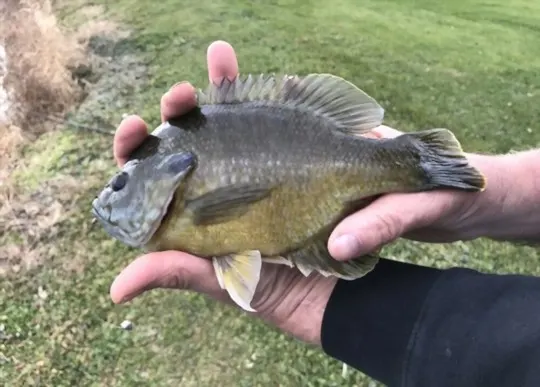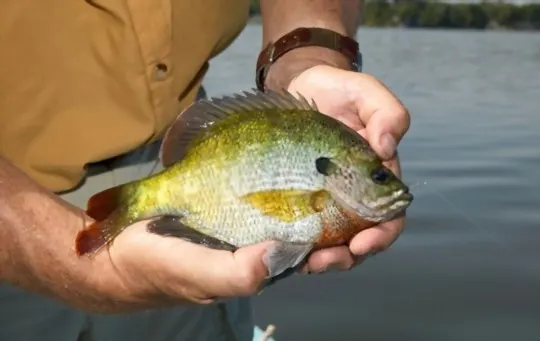Eager to explore new taste sensations?
Are you a fan of fish and want the ultimate gastronomic experience?
Look no further than bluegill, a delicious freshwater fish available in many lakes and streams.
But what does bluegill actually taste like? And how does one prepare it for best results?
In this comprehensive guide, we’ll answer these questions and more about everyone’s favorite tasty treat: bluegill!
Learn all there is to know about its flavor profile, key recipes that feature it, health benefits associated with eating it–the possibilities are endless.
So grab your fishing poles and let’s get started!
What is Bluegill?

Bluegill is a type of freshwater fish that is commonly found in North America.
It is also known as bream, brim, or sunfish.
Bluegill is part of the Centrarchidae family of fishes and is a popular game fish for both recreational and sport purposes.
To understand what bluegill is, it’s important to note that it’s a small freshwater fish that can be distinguished by its blue-ish green color on top, fading to yellow-green on the sides and underneath.
It has a roundish body shape and long dorsal fin with spines.
It also has a relatively large mouth compared to its body size.
Bluegill are typically found in rivers, lakes, ponds, and other fresh bodies of water.
They feed on aquatic insects like mayflies, zooplankton, and smaller fishes.
They spawn during late spring through early fall when the water temperature rises up to 67 degrees Fahrenheit.
Overall, bluegill are a common type of freshwater fish in North America that are sought out for their unique features.
Another notable feature about bluegills is their behavior towards worms or similar bait used as lures while fishing since they are considered quite approachable fish species.
Understanding what bluegills look like will help you recognize them easily next time you see one in your fishing trips or other natural environments where they live.
What Does Bluegill Taste Like?

Bluegill is a freshwater fish that has a mild, sweet taste with firm, white flesh.
It is often described as having a flavor similar to other popular panfish such as crappie and perch.
If cooked properly, bluegill can be an excellent table fare.
There are several ways to prepare bluegill, including frying, grilling, baking, or broiling.
When cooked correctly, the meat should be moist and flaky with a slightly crispy exterior.
Bluegill pairs well with various herbs and spices and can be served with anything from tartar sauce to lemon wedges.
The taste of bluegill can vary depending on the region it was caught in and what it was feeding on at the time.
However, generally speaking, bluegill has a mild flavor that is not overpowering or fishy.
Its sweet taste makes it an ideal choice for those who may be hesitant to try seafood because of its strong taste.
Due to its small size compared to other fish species like salmon or tuna, bluegill may not be widely available in grocery stores.
However, if you have access to fresh bluegill from your local fishing spot or fish market, it’s worth giving this tasty panfish a try.
Factors that Affect the Taste of Bluegill

The taste of bluegill is influenced by several factors, including its diet, size, age, and the water in which it resides.
Let’s take a closer look at these aspects.
- Diet: Bluegills are omnivorous and can feed on a variety of aquatic plants and animals, including insects, crustaceans, and worms. The diet of a bluegill can affect its flavor profile.
- Size: In general, larger fish tend to be fattier and have a richer flavor than smaller ones. However, if the fish is too large or old, its flesh may become tough or chewy.
- Age: Older fish tend to have more pronounced flavors than younger ones because they have had more time to accumulate fat and other nutrients.
- Water quality: The taste of bluegill is also influenced by the water in which it lives. Fish that live in clean or less polluted waters generally have better flavor profiles than those living in dirty waters.
- Season and geography: The season in which the fish is caught also plays a role as well as its geography. Warmer weather tends to bring out nuttier notes whereas colder months lead to bluer tastes from elevated nitrogen compounds produced by algae blooms.
Understanding these factors can help you appreciate how diverse the taste spectrum of this freshwater species.
How you prepare it will influence each unique trait.
As previously explained, several factors can influence the taste of bluegill.
While some are beyond our control (water quality), others are not (diet).
It’s important to note that every angler has different preferences on what makes great-tasting bluegill.
One angler might like their bluegills mild while others prefer them robustly flavored.
Diet, age, and even geography can all play a significant role in the profile of the flesh.
Remember, larger bluegills are prone to have richer flavors as their diet has more variety.
However, size doesn’t always guarantee quality; more often than not, over-aged fish can be tough and chewy.
If you want the best tasting dish make sure you’re stocking up on Bluegill caught during cooler temperatures or well before population explosions that may lead to feeding frenzies that can affect palatability.
Bluegill offer different flavored experiences depending upon where and when they’re caught due to environment and seasonal alteration.
There is no right or wrong answer – experiment with cooking techniques and seasoning until you find the perfect balance for your taste preferences.
How to Cook Bluegill to Enhance Its Flavor?

To enhance the flavor of Bluegill, there are several cooking techniques that you can use.
- Consider using a combination of herbs and spices to add depth to the fish’s natural taste. Some great options are parsley, cilantro, garlic, thyme, and oregano.
- As Bluegill has delicate flesh, it is best cooked with gentle methods of cooking such as pan-frying or grilling. Keep an eye on the fish as it cooks and ensure that it does not overcook.
- If you decide to grill the fish, make sure to brush some oil over the fillets before placing them on the grill. This will help prevent sticking and also add flavor.
- One key element when cooking Bluegill is to keep it moist. To achieve this, baste the fillets with butter or olive oil while they cook. You can also add some lemon juice for a citrusy twist.
Finally, another important factor when it comes to cooking Bluegill is not to overpower its subtle taste with heavy sauces or marinades.
A simple yet tasty mixture of butter and lemon juice can do wonders for enhancing its natural flavors.
By following these tips, you can coax out Bluegill’s unique taste while keeping its delicate texture intact.
Where to Buy Bluegill and How to Store It?

If you’re looking to buy bluegill or wondering how to store it, there are a few things you should know.
- You can typically find bluegill at your local fish market or grocery store. If you live in an area where bluegill is commonly caught, you may also be able to purchase it directly from local fishermen. It’s important to make sure the bluegill is fresh before purchasing it – look for bright eyes, firm flesh, and a clean smell.
- When storing bluegill, the best way to keep it fresh is by putting it on ice as soon as possible after catching or purchasing it. You can also wrap the fish in plastic wrap and store it in the refrigerator for up to two days. To freeze bluegill, wrap it in plastic wrap followed by aluminum foil and store in a freezer-safe container for up to six months.
- In terms of preparing and cooking bluegill, there are many different recipes and methods you can try. Some people prefer to fillet the fish and pan-fry it with butter and breadcrumbs, while others like to grill or bake it with herbs and lemon juice. If you’re new to cooking bluegill, there are plenty of online resources available with step-by-step instructions.
Overall, buying fresh bluegill and storing it properly are key steps in ensuring that your seafood dishes turn out delicious and flavorful.
By using these tips and experimenting with different cooking methods, you can enjoy this tasty fish year-round.
Conclusion
We learned about where to buy Bluegill and how to store it.
Whether you choose to purchase it from a local fish market or catch it yourself, there are several factors to consider when selecting high-quality Bluegill.
Additionally, proper storage methods will help preserve its flavor and texture so that you can enjoy it at its best.
In summary, Bluegill is an excellent choice for anyone who enjoys fresh seafood with a light and delicate taste.
By understanding where to buy it, how to store it properly, what it tastes like and how to cook it in different ways – have all been covered comprehensively above – now there’s nothing left but for you to try this delectable freshwater fish for yourself.

What Does Bluegill Taste Like? A Comprehensive Guide
Ingredients
- Bluegill
- Ingredients from your selected recipes
Instructions
- Select ingredients that work well together.
- Use a recipe or method that will enhance their natural taste.
- Taste and adjust the recipe as needed to achieve the desired flavor.

Carrie is a food writer and editor with more than 15 years of experience. She has worked for some of the biggest names in the food industry, including Bon Appétit, Food & Wine, and Martha Stewart Living.
As the Editor in Chief of IntroChicago.com, Carrie oversees all of the content on the site. She also manages the team of contributing writers and editors, who help to create delicious recipes, helpful tips, and informative articles that you’ll find on the site.
A native of the Chicago area, Carrie is passionate about all things food. She loves trying new restaurants and experimenting with new recipes in her kitchen. She’s also a graduate of the Culinary Institute of America, so she knows a thing or two about food!
